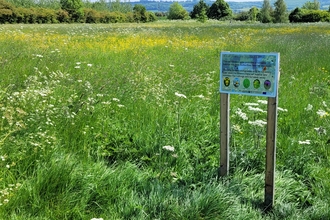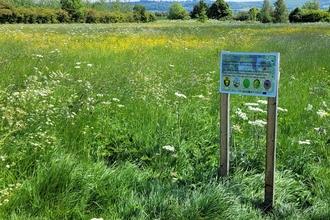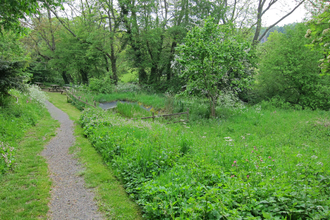At just 0.3ha, Rectory Wood is one of a number of small woodland fragments around the village of Bransford in western Worcestershire. In spite of its small size it is likely to be an important 'stepping stone' for wildlife moving through the area and so it was great to work with Leigh and Bransford Parish Council to restore the site.
Non-native shrubs were making the wood very dark and smothering ground flora so their removal was a key part of the project. Once these plants had been cleared it was possible to replace them with native trees and shrubs, while wildflower bulb planting should help to improve plant diversity of the woodland floor. Some light tree surgery and the installation of bird and bat boxes followed, while the timber from the shrub clearance and tree surgery was used to create log piles that will provide habitat for a range of invertebrates and small animals.
Several different types of bird and bat box were installed throughout the wood, offering nesting and roosting opportunities for a range of species. These boxes will help to replace natural holes and cracks in trees, which aren't available in the wood at the moment because the trees are too young.
We've included some tips for making bird and bat boxes as desirable as possible below:
General rules
- When installing bird and bat boxes it is important to consider flight lines: there should be an open space in front of boxes so that individuals can make a clear flight to the box entrance.
- Bird and bat boxes can be fixed to trees or walls. When fixing a box to a tree, make sure that the tree is strong and healthy and that either aluminium or stainless-steel nails are used (do not hammer the nail all the way in, leave a little space for the tree to grow). When installing bat boxes on buildings it can be beneficial to position them under the cover of the eaves.
- Remember that most bats are averse to artificial light so do not put boxes where they will be illuminated by security lights or other bright light.
- Although well-made wooden boxes can be great, we generally recommended ‘woodcrete’ or ‘woodstone’ boxes as they last longer and provide better protection against predators and extremes in weather.
- Bird and bat boxes can be put up at any time of year, but making sure that they are installed by the late autumn will mean that they can be used as shelter during the winter. This will also give bats and birds time to become accustomed to them before the breeding season.
Bird Boxes
- Most small bird boxes should be installed between 1.5 m and 3 m above the ground, and in areas with lots of disturbance or cats they should be installed above head height.
- They should not face into prevailing winds and should not be exposed to direct sunlight for large parts of the day. This generally means that they should be orientated between east and north, though this is less important in shady, sheltered areas.
- Boxes should be positioned away from bushes and branches that might be used by hunting cats.
- They should ideally be cleaned out during late autumn once the birds have finished breeding but before they begin to use them as winter roosts, so making them reasonably accessible can be beneficial.
Bat boxes
- Bat boxes should be fixed at least 3m above the ground and preferably above 4m. Unlike bird boxes, bat boxes benefit from being warmed by sunlight for at least part of the day.
- It is a good idea to install bat boxes in pairs or trios, orientating them differently so that they offer a range of temperature regimes. This could mean one box facing roughly south, one east, and perhaps another facing west.
- Bats are sensitive to light so boxes should be installed in places where there is no artificial lighting.
- It is helpful to use boxes designed to allow droppings to fall straight out as this reduces the need for maintenance.
- Once installed, bat boxes should only be opened by licenced bat ecologists.
In the video below, our Natural Networks Officer Sean tells us more.
Video by James McDonald, Clear Picture Productions Ltd

Natural Networks funding increased to encourage more wildlife-rich habitats
Natural Networks grants, available for projects which aim to create or restore wildlife-rich habitats, have been increased to cover 70%…

Natural Networks success
A project to connect habitats and increase the abundance of wildlife in Worcestershire is celebrating the securing of funding to extend…

Wildlife and access improvements at The Knapp and Papermill
Work to make improvements for wildlife and people at a popular nature reserve will result in temporary path diversions and a one day…
